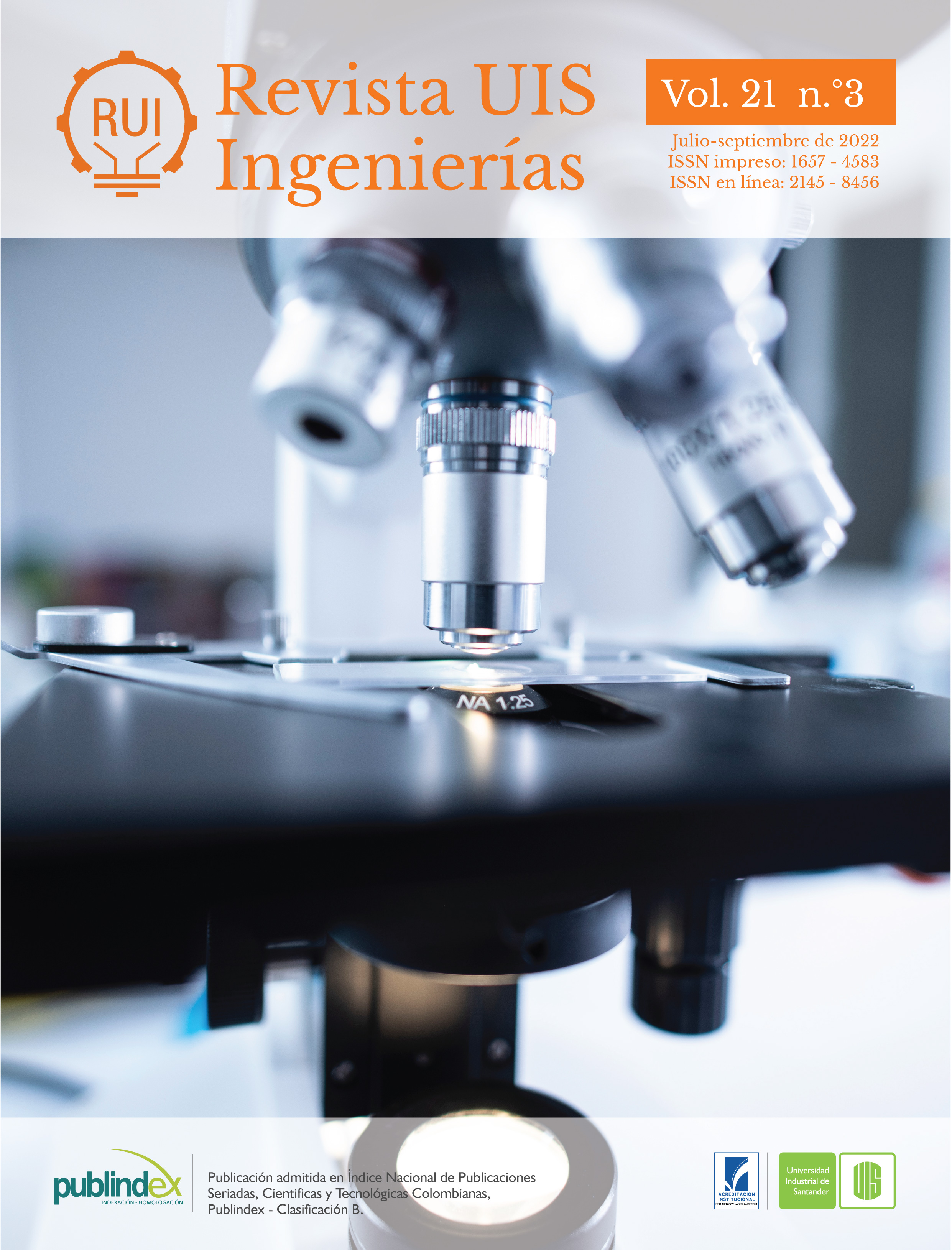Numerical modelling of the lifting process of a hemispherical head of a regenerator
Published 2022-09-30
Keywords
- Solid mechanics,
- strength of materials,
- finite element modeling,
- linear analysis,
- hoisting/lifting operations
- pressure vessels,
- oil refineries,
- computer modeling,
- stress analysis,
- deformation control ...More
How to Cite
Copyright (c) 2022 Revista UIS Ingenierías

This work is licensed under a Creative Commons Attribution-NoDerivatives 4.0 International License.
Abstract
During certain maintenance or capacity-building tasks of operating refinery equipment (e.g. reactors, regenerators, etc.), it is often necessary to remove and subsequently hoist the upper hemispherical head of the equipment. In the lifting phase, the head must be maintained in such a way that the welding between it and the body of the vessel is feasible to perform. This welding can be performed if the deformations in the periphery of the head base are small, otherwise additional adjustment processes must be carried out that can delay the commissioning of the equipment inducing economic losses. In the planning of the hoisting, the determination of the position and the number of ears to be used is important, this will affect the distribution of the loads and consequently the deformations that the periphery of the head will experience. This paper presents a finite element analysis of a hemispheric head of a regenerator during the lifting process. The head is subjected to the action of gravity loads and external loads produced by structural elements connected to the head. In the lifting process, the head is also subjected to the tension forces generated by the lifting cables. From the numerical model, a parametric study was carried out to determine the optimal arrangement of the hoisting clips taking into account the deformations in the periphery of the head base, in order to guarantee the welding process with the body of the vessel. Additionally, the use of a stiffening ring and its influence on the deformation of the head were analyzed.
Downloads
References
- W. H. Hung, S. C. Kang, “Configurable model for real-time crane erection visualization”, Advanced Engineering Software, vol. 65, pp. 1-11, 2013, doi: https://doi.org/10.1016/j.advengsoft.2013.04.013
- S. Han, S. Hasan, A. Bouferguene, M. Al-Hussein, J. Kosa, “An integrated decision support model for selecting the most feasible crane at heavy construction sites”, Automation in Construction, vol. 87, pp. 188-200, 2018, doi: https://doi.org/10.1016/j.autcon.2017.12.009
- H. Taghaddos, U. Hermann, A. Abbasi, “Automated crane planning and optimization for modular construction”, Automation in Construction, vol. 95, pp. 219-232, 2018, doi: https://doi.org/10.1016/j.autcon.2018.07.009
- W. Jiang, Y. Zhou, L. Ding, C. Zhou, X. Ning, “UAV-based 3D reconstruction for hoist site mapping and layout planning in petrochemical construction”, Automation in Construction, vol. 113, 103137, 2020, doi: https://doi.org/10.1016/j.autcon.2020.103137
- Z. Zhang, W. Pan, “Lift planning and optimization in construction: a thirty-year review”, Automation in Construction, vol. 118, 103271, 2020, doi: https://doi.org/10.1016/j.autcon.2020.103271
- C. A. Graciano, D.G. Zapata-Medina, “Effect of longitudinal stiffening on bridge girder webs at incremental launching stage”, Ingeniería e Investigación, vol. 35, no. 1, pp. 24-30, 2015, doi: https://doi.org/10.15446/ing.investig.v35n1.42220
- A. Ayestarán, C. Graciano, O. González-Estrada, “Resistencia de vigas esbeltas de acero inoxidable bajo cargas concentradas mediante elementos finitos”, Revista UIS Ingenierías, vol. 16, no. 2, pp. 61-70, 2017, doi: https://doi.org/10.18273/revuin.v16n2-2017006
- A. Noguera-Garban, C. Graciano, D.G. Zapata-Medina, “Elastic behavior of stiffened curved plates subjected to transverse loading”, Dyna, vol. 85, no. 205, pp. 83-89, 2018, doi: https://doi.org/10.15446/dyna.v85n205.62108
- L. Espinoza, O. A. González-Estrada, C. Graciano, “Análisis de un interno tipo brida de un recipiente horizontal a presión utilizando elementos finitos”, Revista UIS Ingenierías, vol. 18, no. 3, pp. 151-156, 2019, doi: https://doi.org/10.18273/revuin.v18n3-2019015
- E. Araque, C. Graciano, D.G. Zapata-Medina, O.A. González-Estrada, “Compressive strength of partially stiffened cylinders at elevated temperatures,” Revista UIS Ingenierías, vol. 19, no. 1, pp. 131-142, 2020, doi: https://doi.org/10.18273/revuin.v19n1-2020013
- O. González, G. Martínez, C. Graciano, “Evaluación paramétrica de las principales variables geométricas en el diseño de un tren de aterrizaje para un avión no tripulado utilizando el método de los elementos finitos,” Revista UIS Ingenierías, vol. 19, no. 2, pp. 149-160, 2020, doi: https://doi.org/10.18273/revuin.v19n2-2020017
- E. Garrido, E. Casanova. “Stress and strain fields in the hemispherical head of an FCC regenerator during the lifting maneuver in cyclone replacement,” In Proceedings of the ASME 2013 Pressure Vessels and Piping Conference, vol. 3: Design and Analysis. Paris, France. July 14–18, 2013, V003T03A088, ASME. https://doi.org/10.1115/PVP2013-97038
- https://www.cheshire-live.co.uk/news/giant-cranes-huge-lift-oil-6224655
- ANSYS, “ANSYS Release 19R2 Elements Reference”, 2019.
- American Society of Mechanical Engineers. Boiler and Pressure Vessel Committee, BPVC Section VIII-Rules for Construction of Pressure Vessels Division 1. ASME, 2017.
- R. Goncalves, Introducción al Análisis de Esfuerzos, 3rd ed. Caracas: Editorial Equinoccio, 2011.

